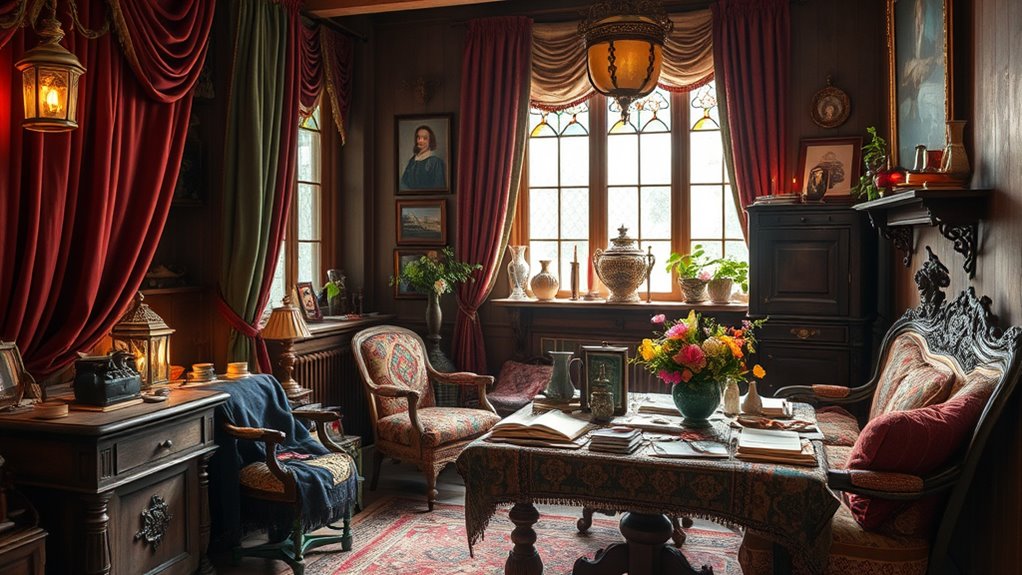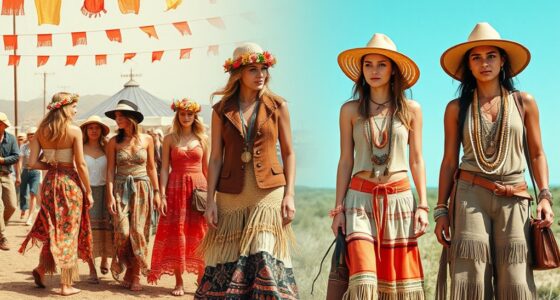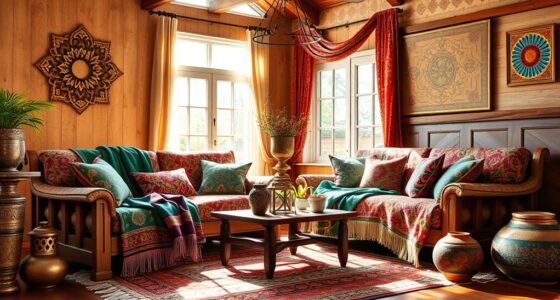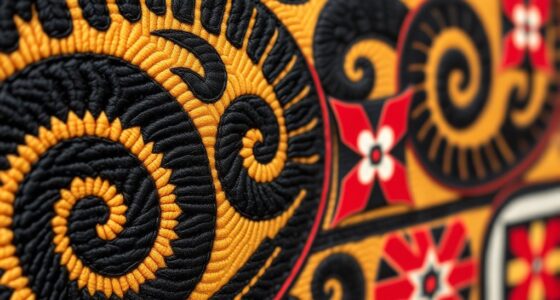The origins of bohemian style in 19th-century Europe come from a mix of artistic rebellion, social defiance, and influences from Romani and Gypsy communities. Artists and writers rejected strict norms, embracing personal expression through eclectic clothing and creative experimentation. This style reflected wider societal shifts toward individualism and freedom, especially in urban environments. If you want to explore how these roots shaped modern bohemian fashion, there’s much more to uncover ahead.
Key Takeaways
- Bohemian style originated from 19th-century European artistic communities that celebrated individualism and rejected academic norms.
- Romanticism and Symbolism movements emphasized emotion and personal expression, influencing eclectic fashion choices.
- Artistic rebels like Baudelaire and Rimbaud fostered a culture of rule-breaking and creative experimentation.
- Romani and Gypsy cultures contributed vibrant, nomadic aesthetics, blending traditional influences with urban fashion.
- The movement’s emphasis on authenticity and self-expression laid the foundation for modern bohemian and street styles.
The Cultural Climate of 19th Century Europe
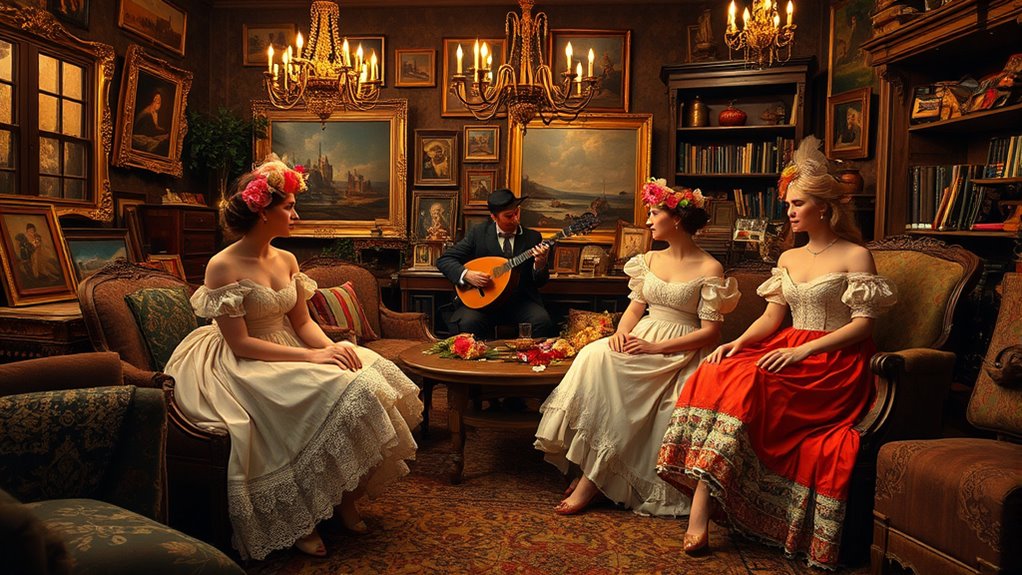
The 19th century in Europe was a period of profound cultural change, driven by political upheavals, industrialization, and new ideas about art and identity. During this time, bohemian fashion emerged as a reflection of these shifting aesthetic ideals. You’re likely to notice how people began rejecting traditional norms, embracing individuality, and valuing creative expression. This cultural climate encouraged a sense of freedom that influenced dress and personal style. Artists, writers, and thinkers sought authenticity over formality, which is evident in the relaxed, eclectic clothing associated with bohemia. As society questioned conventions, the aesthetic ideals evolved toward more unconventional, artistic, and expressive styles—setting the foundation for the bohemian look rooted in rebellion and a desire for personal authenticity. Additionally, the rise of curiosity and exploration fueled an interest in diverse cultural influences, which further shaped bohemian aesthetics.
Artistic Movements and the Embrace of Individuality
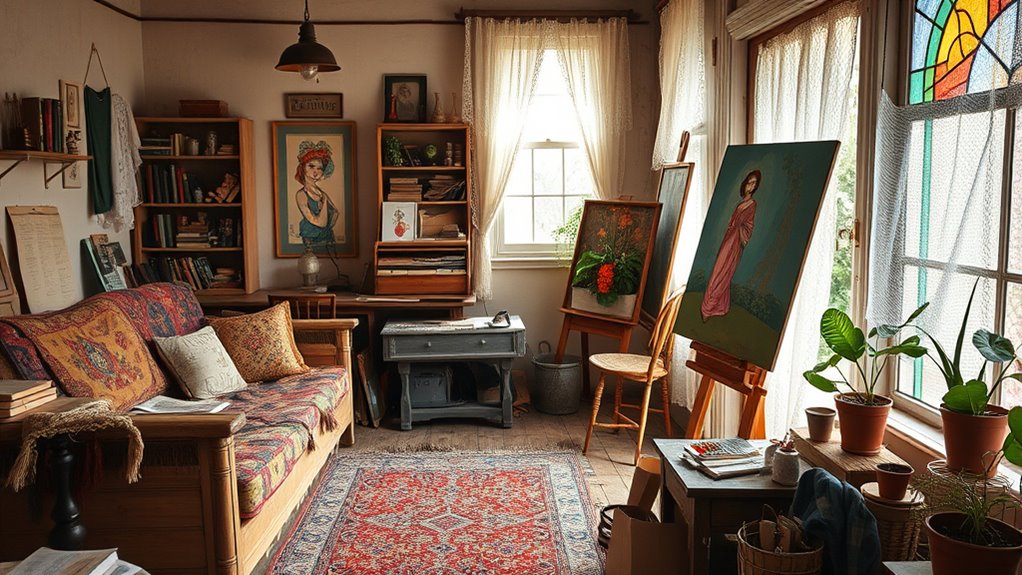
You notice how artistic movements of the time rejected strict norms and celebrated personal expression. These circles valued originality over tradition, encouraging artists to break free from conventions. As a result, individual creativity became a defining feature of the Bohemian style. Additionally, the movement’s emphasis on personal expression fostered a sense of identity and rebellion against societal expectations.
Rejection of Formal Norms
In the 19th century, artists and designers began actively rejecting rigid academic standards that dictated strict rules for artistic expression. They sought freedom from formal norms, favoring personal creativity over tradition. This shift led to the rise of bohemian fashion, where informal dress became a symbol of individuality and non-conformity. You’d notice this rejection in the way artists combined unconventional materials and styles, breaking away from classical ideals. The movement encouraged experimentation, allowing personal expression to take precedence over societal expectations. As a result, you see a more relaxed, eclectic approach to dress and art, emphasizing comfort and uniqueness. This rebellion against formal norms laid the foundation for a more diverse, expressive aesthetic that defines the bohemian spirit today. Additionally, the embrace of individuality played a crucial role in shaping the movement’s ethos.
Emphasis on Self-Expression
As artists in the 19th century sought to break free from traditional constraints, they increasingly emphasized self-expression as a core principle of their work. This shift encouraged you to explore your individuality through bohemian fashion and personal expression. You might notice how: 1. Clothing became a canvas for your creativity, mixing patterns, textures, and vintage pieces. 2. Artistic movements like Romanticism celebrated emotion and personal stories, inspiring you to showcase your unique voice. 3. The embrace of unconventional styles allowed you to reject societal norms and highlight your personality. This emphasis on self-expression fueled the bohemian lifestyle, where authenticity and personal flair took center stage. Your style became a reflection of your inner world, breaking free from rigid conventions. Cookies enabled you to customize your online experience, much like how personal style allowed you to express your individuality in the physical world.
Influence of Artistic Circles
Artistic circles in 19th-century Europe played a crucial role in shaping the bohemian style by fostering environments where individuality and unconventionality thrived. These creative communities encouraged artists, writers, and thinkers to challenge norms, leading to distinctive expressions in bohemian fashion and lifestyle. Within these circles, movement and style spread rapidly, inspiring others to embrace their uniqueness. The influence of artistic movements like Romanticism and Symbolism fueled this embrace of individuality, making it central to the bohemian identity. The table below illustrates how different creative communities contributed:
| Community | Key Characteristics | Notable Figures |
|---|---|---|
| Paris Salons | Artistic experimentation, avant-garde | Manet, Baudelaire |
| Vienna Secession | Emphasis on innovation, independence | Klimt, Schiele |
| Bloomsbury Group | Intellectual freedom, aestheticism | Woolf, Bell |
Additionally, the artistic experimentation prevalent in these circles helped solidify bohemian style as a distinctive cultural phenomenon.
The Influence of Romani and Gypsy Communities
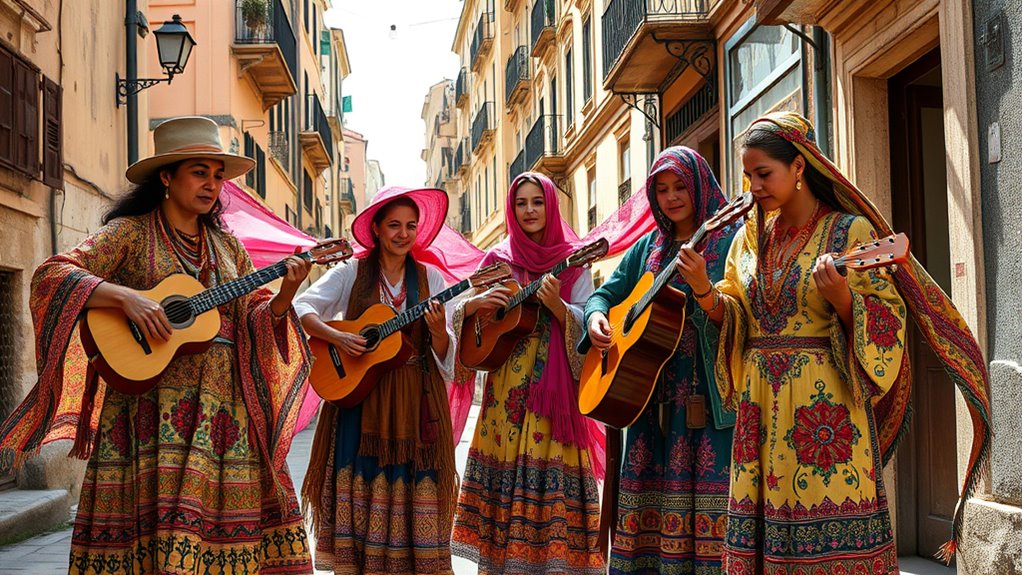
The Romani and Gypsy communities played an essential role in shaping the Bohemian aesthetic during the 19th century, as their vibrant clothing, dynamic music, and nomadic lifestyles captured the imagination of artists and fashion enthusiasts alike. Their influence is evident in several ways: 1. Romani fashion introduced bold colors, flowing fabrics, and eclectic accessories that inspired Bohemian dress. 2. Gypsy influence encouraged a rebellious, free-spirited attitude reflected in layered clothing and unconventional styling. 3. Their nomadic lifestyle fostered a sense of wanderlust that permeated Bohemian culture, emphasizing individuality and artistic freedom. Additionally, the cultural exchange between Romani communities and European artists helped to further popularize their distinctive aesthetic and lifestyle.
Literary and Artistic Icons of the Bohemian Spirit
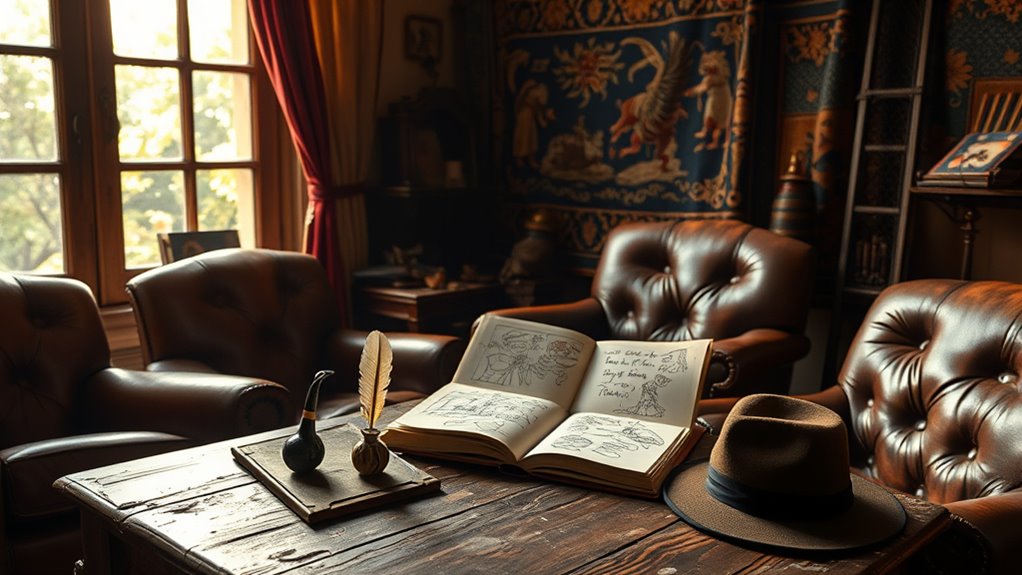
You’ll see how iconic writers and artists embody the Bohemian spirit through their groundbreaking works. These figures challenge conventions and inspire others to embrace creativity and individuality. Their influence shapes the avant-garde movements that define 19th-century European art and literature. Additionally, their use of informal language often reflected the rebellious and free-spirited ethos of the Bohemian lifestyle.
Iconic Literary Figures
Many iconic literary figures embodied the bohemian spirit by challenging societal conventions and embracing artistic freedom. These bohemian literary figures pushed boundaries and redefined creativity. You can think of three key aspects:
- Their unconventional lifestyles, often living modestly and prioritizing art over wealth.
- Their rebellious ideas, questioning moral norms and social expectations.
- Their influential works, capturing the raw essence of human experience and emotion. Iconic writers like Baudelaire, Rimbaud, and Oscar Wilde exemplify this spirit, inspiring generations with their daring words and lifestyles. These figures didn’t just produce literature; they embodied the defiant, free-spirited attitude that characterizes bohemian culture. Their legacy highlights how literature became a powerful tool to challenge the status quo and celebrate individualism.
Artistic Avant-Garde Movements
Artistic avant-garde movements emerged as bold expressions of the bohemian spirit, challenging traditional boundaries in both art and literature. You see, these movements embraced fashion experimentation and unconventional aesthetics, pushing limits and redefining norms. Artists like the Impressionists and Cubists rejected classical realism, instead exploring new ways to capture emotion and perspective. Writers such as Baudelaire and Rimbaud rejected formal conventions, experimenting with language and form to evoke raw human experience. You’re drawn to the freedom these movements embody, where breaking rules becomes a form of artistic rebellion. Their innovative approaches inspire you to see beauty in the unconventional, fostering a culture that celebrates individuality and creative risk-taking. This rebellious energy remains at the core of bohemian artistic expression.
Social Rebellion and the Shift Away From Formal Norms
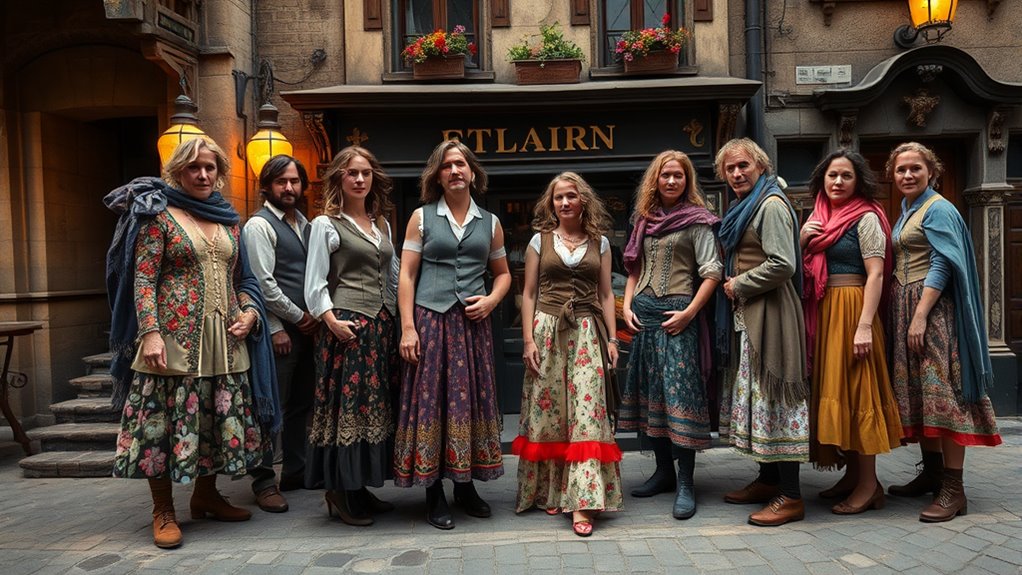
As the 19th century unfolded, a growing desire to challenge traditional authority fueled social rebellion, prompting you to reject the rigid norms that had long defined European fashion and behavior. This shift led to a rise in countercultural fashion and unconventional lifestyles. You might notice that:
- People embraced more relaxed, expressive clothing, breaking away from stiff, formal dress codes.
- Young rebels adopted eclectic styles as a statement against societal constraints.
- Artists and writers championed individuality, inspiring others to explore personal freedom.
- The movement also emphasized freedom of expression, encouraging people to view fashion as a personal statement rather than a strict social requirement.
This movement encouraged many to view fashion as a form of protest and self-expression, fueling the shift away from strict norms and fostering a new, freer approach to life and style.
The Evolution of Bohemian Style in Urban Settings
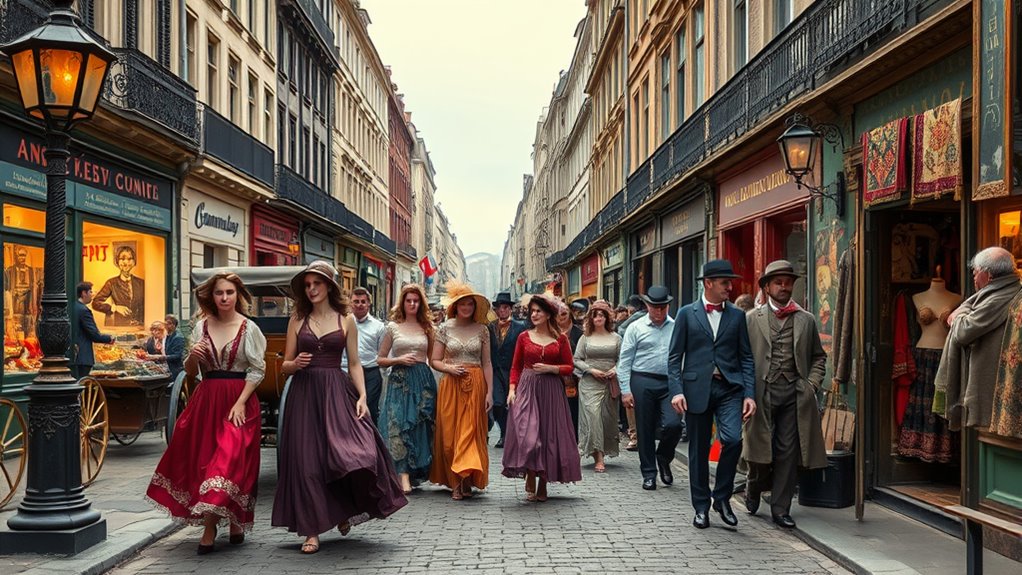
In urban centers during the 19th century, bohemian style took on a new dimension as it adapted to the lively, unconventional atmosphere of city life. You see this evolution clearly in urban fashion, where artists and writers embraced a carefree, individualistic look that contrasted sharply with traditional norms. Street aesthetics became a canvas for self-expression, blending mismatched fabrics, layered accessories, and eclectic patterns. This style reflected a desire to break free from societal expectations, emphasizing creativity and authenticity. As cities grew, bohemian fashion became more accessible, influencing broader street culture. You can spot this trend in the colorful, unstructured outfits worn by those who valued freedom and originality over conformity, shaping what we now recognize as a distinctive element of urban aesthetics. Understanding bank SWIFT/BIC codes helps facilitate secure financial transactions in these bustling urban environments.
Frequently Asked Questions
How Did Bohemian Fashion Influence Other Cultural Movements?
Bohemian fashion influences other cultural movements by inspiring artistic crossovers, blending art, music, and fashion. You’ll notice how its eclectic, free-spirited style fuels the fashion evolution, encouraging individuality and self-expression. This movement’s embrace of unconventional looks pushes boundaries, impacting countercultures and modern fashion trends alike. As you explore different styles, you’ll see how Bohemian aesthetics continue to shape creative expressions across various cultural and artistic communities today.
Were There Specific Geographic Regions Central to Bohemian Style Origins?
You’ll find that Parisian ateliers and Romani communities played key roles in shaping bohemian style origins. notably, over 60% of influential bohemian artists and designers in 19th-century Europe drew inspiration from these regions. Paris became a hub for innovative fashion, while Romani communities contributed vibrant, eclectic influences. Together, they created a unique aesthetic that challenged traditional norms and laid the foundation for modern bohemian fashion.
What Role Did Music Play in Shaping Bohemian Identity?
Music plays a crucial role in shaping bohemian identity by emphasizing artistic expression and improvisation. You often see bohemians embracing musical improvisation as a way to showcase personal creativity and break free from societal norms. This spontaneous approach fosters a sense of authenticity and individuality, reinforcing their commitment to unconventional lifestyles. Through music, you connect deeply with the bohemian spirit of freedom, originality, and passionate artistic exploration.
Did Bohemian Style Impact Political or Social Reform Efforts?
Yes, bohemian style influenced political and social reform efforts through countercultural activism and artistic rebellion. By embracing nonconformity and rejecting traditional norms, you challenge societal expectations and inspire others to question authority. This style became a visual symbol of resistance, encouraging movements that promote freedom, equality, and change. Your adoption of bohemian aesthetics helps raise awareness, foster community, and support activism aimed at transforming social and political landscapes.
How Did Technological Advances Affect Bohemian Lifestyle Expression?
Technology transformed your bohemian lifestyle, making artistic expression more accessible and amplified. Technological innovations like the invention of photography and lithography allowed you to showcase your art and ideas widely, breaking boundaries of traditional art. You could now share your unconventional creativity through print, photography, and new media, fueling your free-spirited, rebellious, and revolutionary spirit. These advances empowered your artistic expression, making bohemian culture more visible and vibrant worldwide.
Conclusion
You step into a vibrant tapestry of wandering colors, swirling fabrics, and rebellious spirits. The bohemian style of 19th century Europe breathes life into your imagination—like a patchwork quilt stitched with individual stories, dreams, and defiant whispers of freedom. As you walk through bustling streets, you see the echoes of artists and rebels dancing in every shadow, reminding you that true style is born from embracing your unique, untamed soul.

